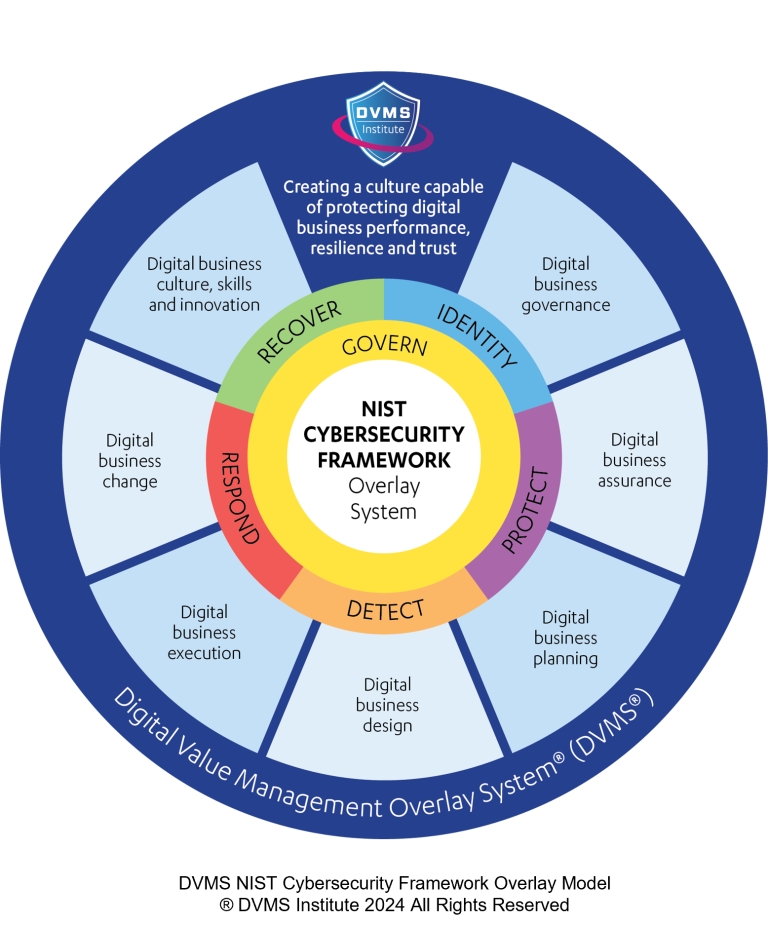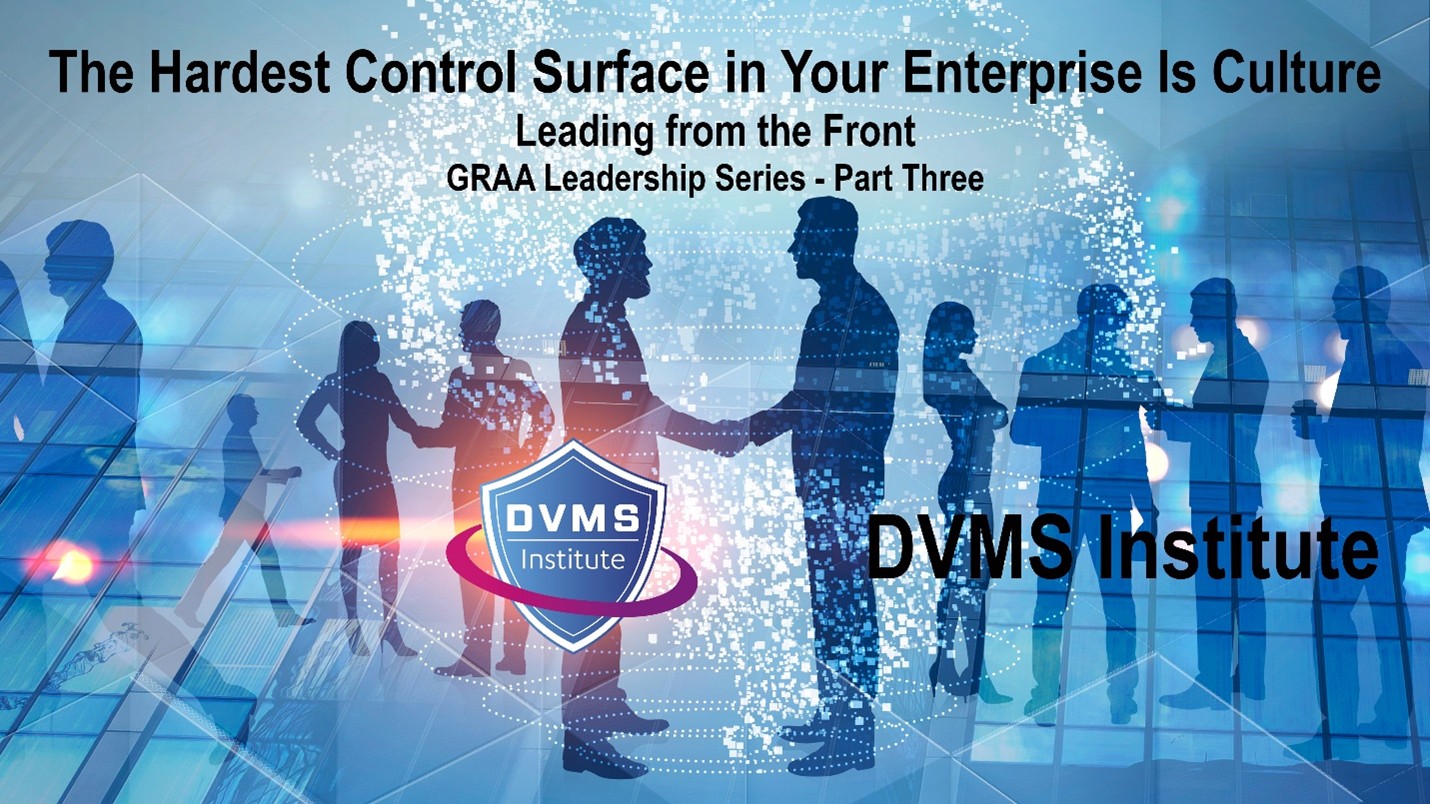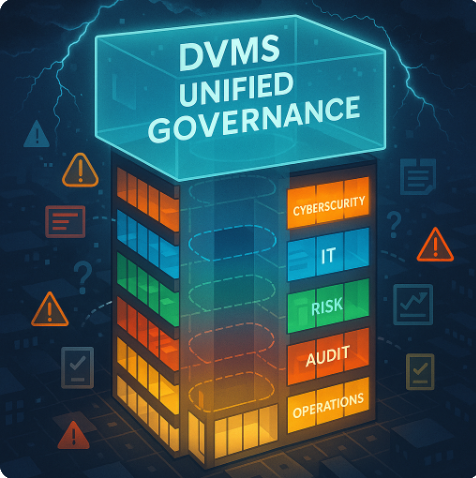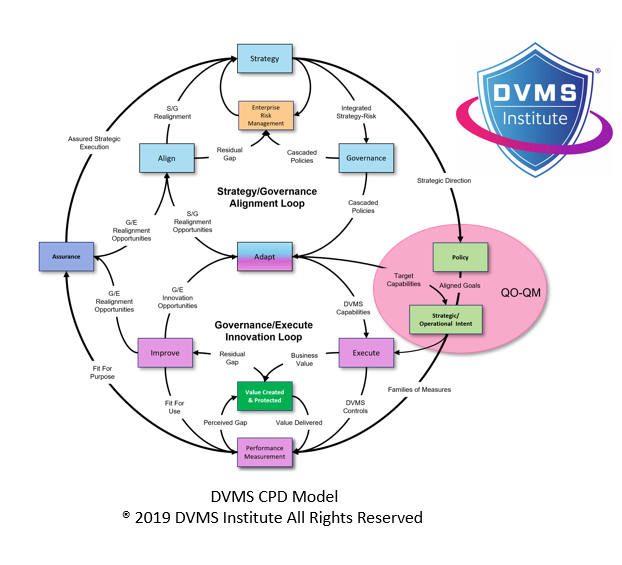Rethinking Organizational Resilience: The Power of the Overlay and Culture in a Digital Enterprise
David Moskowitz, Executive Director and Content Architect
Digital organizations today grapple with mounting pressure to enhance their resilience, governance, and assurance across an enterprise and its supply chain. Meeting these demands requires innovative strategies that can adapt to the complex realities of modern digital enterprises. In response, the DVMS Institute has introduced a groundbreaking tool for managing organizational change to drive organizational governance, assurance, and business resilience: the overlay.
This overlay, paired with seven minimum viable capabilities (MVC), goes beyond traditional frameworks by offering a scalable, flexible method for improvement. Unlike frameworks that rely on a static, one-size-fits-all structure, the overlay empowers organizations to pinpoint gaps between their current state and desired outcomes. Designed to adapt to organizations of any size, sector, or industry, the overlay equips organizations with a tailored roadmap for digital business success. Its adaptability ensures relevance and effectiveness, regardless of organizational context or maturity.
The Power of the Overlay
The overlay offers a versatile structure that organizations adapt to meet their unique needs. By integrating the overlay into their existing practices, organizations can uncover gaps and identify opportunities for meaningful improvement. This tailored approach ensures enhancements align with specific goals and priorities, supporting more effective decision-making and execution.
Key Benefits of Using the Overlay:
- Identifying Gaps and Opportunities: The overlay enables organizations to recognize areas where performance can be refined or enhanced, creating a clear path toward targeted improvement.
- Prioritizing Initiatives: The overlay helps organizations focus their efforts where they matter most, driving meaningful outcomes by highlighting the most impactful areas for development.
- Measuring Progress: Organizations can use the overlay to establish benchmarks and track their advancements over time, ensuring that improvement efforts remain aligned with desired outcomes.
- Fostering Continual Improvement: The overlay promotes a mindset of ongoing learning and development, encouraging organizations to evolve and adapt as they grow or as circumstances change.
This flexible, results-oriented approach ensures that organizations address current challenges and build the capacity to thrive in the future. The overlay provides a robust foundation for achieving sustainable progress by focusing on scalable and adaptable strategies.
The Minimum Viable Capabilities (MVC)
The Minimum Viable Capabilities (MVC)—Govern, Assure, Plan, Design, Change, Execute, and Innovate—form the foundation of overlay scalability and universality. The MVC represents activities every organization already performs in some form, regardless of its size, industry, or sector. The universality of the MVC reflects their inherent scalability: everything an organization does can be mapped to one or more of these capabilities, enabling the overlay to align seamlessly with any organizational structure or maturity level.
The MVC are not isolated silos; they are interconnected and interdependent, each influencing and supporting the others. This interconnectedness ensures that improvement efforts using the overlay reflect the entire organizational operational ecosystem. For example:
- Plan: Beyond achieving outcomes, Plan serves as the foundation for governance and assurance activities, ensuring that organizational actions align with strategic objectives and compliance requirements.
- Design: Design relies on Plan to define solutions that meet strategic goals, ensuring that innovations and changes are intentional and effective.
- Change: Change often stems from Plan or Innovate, and relies on Design and Execute to implement adjustments that drive organizational growth or resilience.
- Execute: Execute translates plans, designs, and changes into action. It ensures that initiatives move from concept to implementation, turning strategic objectives into measurable results.
- Govern and Assure: These capabilities act as oversight mechanisms, spanning all MVC to ensure compliance, manage risk, and maintain accountability across organizational efforts.
- Innovate: Innovation includes gap analysis to determine how organizational impact can be enhanced, driving forward-thinking solutions while integrating seamlessly with and improving the other capabilities.
Understanding the interdependencies among the MVC allows organizations to adopt a comprehensive approach to improvement. Instead of replacing existing capabilities, these should serve as an overlay to enhance awareness and collaboration across initiatives. By mapping current organizational practices to these capabilities, organizations can evaluate their strengths and pinpoint areas needing development. This process uncovers opportunities for cooperation and efficiency while ensuring that improvement efforts are based on a holistic understanding of organizational operations.
The success of the overlay relies on the MVC, which provides organizations with a scalable, flexible tool for bridging the gap between their current state and their aspirations. Whether improving governance, enhancing innovation, or executing strategic plans, combining the overlay and MVC offers a clear, actionable roadmap for meaningful and sustainable growth.
The Role of Culture in the Overlay and MVC
While the overlay and MVC provide the structural and operational foundation for improvement, organizational culture is pivotal to their effectiveness. Culture drives how change and tools are adopted, interpreted, and implemented. Without an intentional focus on fostering a culture that supports collaboration, learning, and accountability, even the most well-intentioned changes will likely fail to meet expectations.
A positive and supportive culture fosters learning and innovation, encourages risk-taking, and facilitates change. Conversely, a toxic or overly bureaucratic culture creates resistance, hinders the adoption of new approaches, and stalls progress. Recognizing this, a cultural assessment becomes a critical prerequisite for applying the overlay. By understanding the culture, leaders can pinpoint potential barriers and craft strategies to address them, ensuring a smoother and more effective implementation.
Key Cultural Considerations:
- Leadership Style: Supportive and empowering leadership inspires innovation and encourages risk-taking, creating an environment where employees feel safe to propose and experiment with new ideas.
- Employee Engagement: Highly engaged employees are more likely to embrace change, contribute proactively to improvement initiatives, and align their efforts with organizational objectives.
- Communication: Open and effective communication fosters transparency, trust, and collaboration, builds alignment, and ensures that all stakeholders clearly understand goals, processes, and expectations.
- Learning Culture: Organizations prioritizing learning and continuous innovation are more adaptable to change and better equipped to respond to internal and external shifts.
The overlay and the MVC, when combined with cultural alignment, encourages:
- Collaboration: Teams and departments must actively engage with one another to leverage MVC interconnectedness. This requires a culture that values open communication and shared goals.
- Learning and Adaptability: A continuous learning culture ensures that organizations adapt to changes and proactively seek improvement opportunities. This aligns closely with the overlay focus on scaling and evolving to meet diverse organizational needs.
- Accountability: Overlay effectiveness depends on a culture in which individuals and teams take ownership of their roles within the MVC, ensuring that governance and assurance mechanisms are theoretical and operational realities.
Integrating culture with the overlay and MVC empowers organizations to maximize their potential by aligning people, processes, and purpose. It underscores that organizational improvement is not solely a structural or procedural endeavor but also a profoundly human one. By fostering the right cultural mindset combined with the power of the overlay and the MVC, organizations can unlock their ability to achieve sustainable, transformative change.
The interconnected nature of the MVC highlights the importance of collaboration and alignment across organizational activities. However, without a supportive culture, even the best-designed approach may struggle to reach its full potential. By merging the structural advantages of an overlay with an emphasis on cultural transformation, organizations can foster an environment where innovation and adaptability thrive.
This dual approach ensures that improvement extends beyond merely addressing operational gaps. It integrates the principles of growth, learning, and resilience into the organizational core. Leaders who focus on cultural factors and the technical aspects of the overlay and MVC can achieve meaningful and lasting enhancements in performance and capacity.
About the Author

David Moskowitz
Co-Founder and Content Architect of the DVMS Institute
DVMS Institute is a renowned provider of accredited (APMG International), Assured (NCSC-GCHQ-UK), and Recognized (DHS-CISA-NICCS) NIST Cybersecurity Framework, certification training programs designed to teach organizations of any size, scale, or complexity how to manage their organizational cyber risk and resiliency.
For cyber risk management, the DVMS FastTrack model provides a phased approach to adapting the NIST Cybersecurity Framework functions and its controls across an enterprise and its supply chain to identify and mitigate organizational cyber risks.
For cyber resilience management, the DVMS-CPD model teaches a holistic approach to digital value resiliency by connecting digital system outcomes to a culture of innovation trained to create, protect, and deliver organizational digital value.
David is a Founding Member and Executive Director of the DVMS Institute LLC. He is the lead author of the “Digital Value Management System®” series. The first two books in this series, *Fundamentals of Adopting the NIST Cybersecurity Framework* and *A Practitioner’s Guide to Adapting the NIST Cybersecurity Framework*, are currently available. An upcoming business book titled *Thriving on the Edge of Chaos* is scheduled for release in January 2025 by TSO
® DVMS Institute 2025 All Rights Reserved




